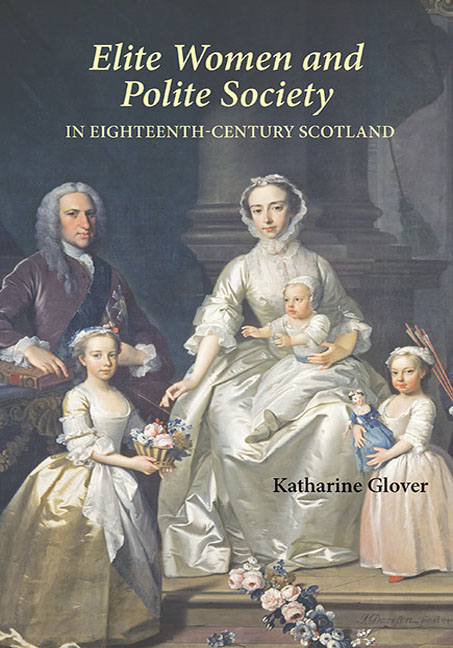Book contents
- Frontmatter
- Contenst
- Dedication
- Acknowledgements
- List of Abbreviations
- Preface
- 1 Elite Women and Eighteenth-Century Scottish Society
- 2 Education and Upbringing
- 3 Reading and Print Culture
- 4 Polite Sociability: Space and Social Practices
- 5 Politics and Influence
- 6 Travel, Tourism and Place
- Conclusion
- Appendix Biographical Backgrounds
- Bibliography
- Index
Appendix - Biographical Backgrounds
Published online by Cambridge University Press: 08 April 2017
- Frontmatter
- Contenst
- Dedication
- Acknowledgements
- List of Abbreviations
- Preface
- 1 Elite Women and Eighteenth-Century Scottish Society
- 2 Education and Upbringing
- 3 Reading and Print Culture
- 4 Polite Sociability: Space and Social Practices
- 5 Politics and Influence
- 6 Travel, Tourism and Place
- Conclusion
- Appendix Biographical Backgrounds
- Bibliography
- Index
Summary
Mary Adam(1699–1761) and daughters
Mary Robertson, daughter of William Robertson of Gladney, minister of Greyfriars Church in Edinburgh, married the architect William Adam, one of early eighteenth-century Scotland's premier architects. They had several children, of whom the most famous was Robert, who after four years studying classical style and cultivating influential acquaintance in Rome set up business in London, eventually fulfilling his dream of becoming one of the most fashionable architects in eighteenth-century Britain. Mary is perhaps best known as the subject, as a widow, of a portrait by her son Robert's sometime friend Allan Ramsay. She was the aunt of the historian William Robertson, who spent much time with the Adam family after the death of his parents, later frequenting their London townhouse.
Her daughters included Jenny, Betty, Nelly, Peggy and Susannah, who in 1753 married John Clerk of Eldin (eldest son of Janet Clerk, below). Although relatively few of these women's own letters remain from the period covered by this book, their interests and personalities come across in the detailed and often gossipy letters written to them by their brothers Robert and James: Nelly was musical and fashionable; Peggy similarly fond of amusements although prone to melancholy; Betty a capable manager. By 1760, Mary and some of her daughters had moved south to London, where they helped with the management of the household and family architectural practice.
Janet Clerk, née Inglis(ca. 1686–1760)
Daughter of Sir John Inglis of Cramond and Anne Cockburn, in 1709 she became the second wife of Sir John Clerk of Penicuik, second baronet (1676– 1755). One of the Commissioners for the 1707 Union, Clerk of Penicuik later served briefly as a member of the British parliament. An active improver, antiquarian and musician, he has been described as ‘the leading Scottish patron of arts and sciences’. They had sixteen children together (the last born when Janet was fifty-one years old), including Johanna (Jackie) whose letters to her father as a young woman covered topics from books to travel to landscape gardening. The Clerk homes at Penicuik and Mavisbank were the haunt of many literati, in particular the poet Allan Ramsay, who in 1730 celebrated the couple in his poem ‘The Happy Man’. William Aikman painted Janet as a young woman.
- Type
- Chapter
- Information
- Elite Women and Polite Society in Eighteenth-Century Scotland , pp. 173 - 182Publisher: Boydell & BrewerPrint publication year: 2011



